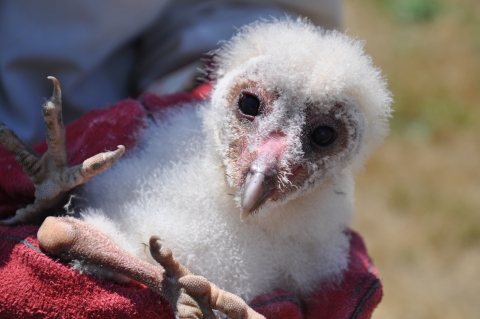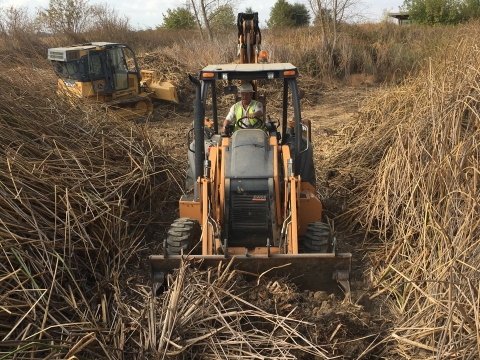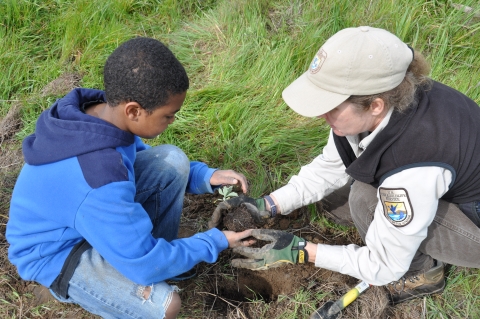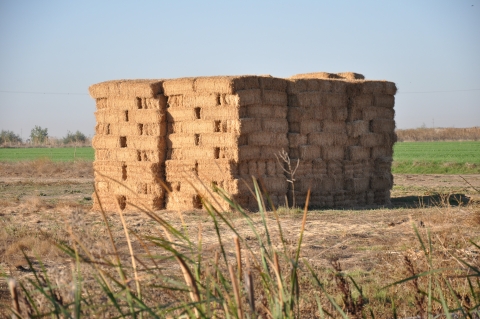What We Do
The staff and partners at Stone Lakes NWR work year-round maintaining and enhancing the refuge lands and programs for both the wildlife and community. Please help the refuge maintain a safe visitor experience by following the rules and regulations.
Management and Conservation
Stone Lakes NWR staff, along with many partners, spend many hours in the field working for the resource and improving the quality and health of wildlife habitats. Below are some of the resource management techniques used at the refuge:
Wildlife Monitoring
Wildlife monitoring occurs throughout the year with the additional help of many volunteers and refuge partners. Nest box monitoring, bird-banding, wetland surveys, Sandhill crane leg band counts, and vegetation surveys are regular programs, building our wealth of data and knowledge of changes and trends with the wildlife and associated habitats over time. Through these programs the information collected enables the refuge to make informed habitat and wildlife based decisions each year and analyze past and future trends.
Managed Wetlands
Our wetland habitat enhancement efforts, in cooperation with private, state, and other federal partners, have yielded more than 566 acres of improved wetlands on five properties within the refuge boundary. Our wildlife monitoring shows a strong, positive response by wildlife, with increases in both the varieties and numbers of birds, other wildlife, and native plants. Historically an area that once supported an abundance of wetlands teeming with wildlife, the refuge now manages the restored wetlands with water control structures, pumps, and vegetation control. This water manipulation allows the refuge to monitor and target specific plant and bird species through flood-up, rotation, depth, and drawdown in fall through early spring. Throughout the summer, most of the managed wetlands are dry to help prevent vegetation overgrowth and mosquito control.
Habitat Restoration
An important backbone to any successful wildlife refuge is restoring and maintaining healthy habitat for the wildlife. Habitat is the home for wildlife, providing food, shelter, water and space. Without proper healthy habitat, many of the wildlife species including birds, mammals, fish, reptiles, amphibians and insects would disappear, further disrupting the web of life. Restoring habitat is a time consuming process, and thanks to many of our partners, school groups and volunteers, it is being restored on many areas within the refuge boundary.
Invasive Species Control
With the introduction of numerous exotics and the mild Mediterranean climate in the Central Valley, the refuge spends a large portion of time maintaining the quality of wildlife habitat though invasive species invasive species
An invasive species is any plant or animal that has spread or been introduced into a new area where they are, or could, cause harm to the environment, economy, or human, animal, or plant health. Their unwelcome presence can destroy ecosystems and cost millions of dollars.
Learn more about invasive species control. Some of the refuges biggest at this time are water hyacinth, yellow star thistle, perennial pepperweed, barbed goatgrass, stinkwort, bristly oxtongue, medusahead grass, and shortpod mustard. These exotics can be expensive and time consuming to control, so the refuge uses many management techniques such as mowing, herbicide spraying, disking, grazing, and prescribed burning. Controlling these invasive species is critical to providing a healthy habitat for residential and migratory wildlife.
Grazing
The refuge has initiated a grazing program using cattle to reduce fire danger, encourage native grasses, and improve foraging conditions for residential and migratory grassland birds, such as sandhill cranes, burrowing owls, western meadowlarks, long-billed curlew, Swainson's hawks, geese, and various waterfowl on the North Stone Lake property. Grazed grasslands also open up the habitat for raptors and snakes in search of small rodents, as well as create potential burrowing owl sites. As open land and grassland habitat disappear at alarming rates in the Central Valley, these lands will become increasingly invaluable for many of these species in jeopardy of declining populations.
Agriculture
Many wildlife species can coexist with some farming practices, particularly species that enjoy grain crops such as geese and sandhill cranes. Hawks, owls, and coyotes also use the fields in search of rodents, as well as many species of snakes and mammals. Currently the refuge uses a winter wheat cover crop on part of the land to provide this additional food source for migratory species. The crops also create a monoculture and help prevent an invasive seedbank to develop on the land, such as star thistle and pepperweed.
Prescribed Burns
Fire is an integral part of the natural process of restoring healthy land and has been used for thousands of years by the Native Americans here in the Central Valley. Fire reduces the dry matter (fuel load) of an area creating a safer environment for the following year and the burned debris immediately puts available nutrients back into the soil. The available nutrients then produce higher quality plants in the burned area, which in turn creates a higher quality habitat for the wildlife. Controlled burns also are used as a means to reduce non-desired plants, encourage local native plants that are adapted to the fire regime, and provide fire breaks during the dry summer.
Refuge Planning
National Wildlife Refuge planning sets the broad vision for refuge management and the goals, objectives, strategies, and actions required to achieve it. Planning ensures that each refuge meets its individual purposes, contributes to the Refuge System’s mission and priorities, is consistent with other applicable laws and policies, and enhances conservation benefits beyond refuge boundaries.
Comprehensive Conservation Plans
Comprehensive Conservation Plans (CCPs) are the primary planning documents for National Wildlife Refuges. As outlined in the National Wildlife Refuge System Administration Act, as amended, the U.S. Fish and Wildlife Service (Service) is required to develop CCPs that guide refuge management for the next 15 years. CCPs articulate the Service’s contributions to meeting refuge purposes and the National Wildlife Refuge System mission. CCPs serve as a bridge between broad, landscape-level plans developed by other agencies and stakeholders and the more detailed step-downs that stem from Refuge CCPs.
The 2007 Final Comprehensive Conservation Plan for Stone Lakes National Wildlife Refuge can be found here: https://ecos.fws.gov/ServCat/Reference/Profile/44003
Step-down Plans
CCP step-down plans guide refuge-level programs for: (1) conserving natural resources (e.g., fish, wildlife, plants, and the ecosystems they depend on for habitat); (2) stewarding other special values of the refuge (e.g., cultural or archeological resources, wilderness, wild and scenic rivers, etc.); and (3) engaging visitors and the community in conservation, including providing opportunities for wildlife-dependent recreation. Like CCPs, step-down plans contribute to the implementation of relevant landscape plans by developing SMART (Specific, Measurable, Achievable, Relevant, and Time-bound) objectives, strategies, implementation schedules, and decision support tools to fulfill refuge visions and goals. This ensures that refuges are managed in a landscape context and that conservation benefits extend beyond refuge boundaries.
Our Projects and Research
Stone Lakes NWR hosts a number of research projects ranging from partnering with local agencies to college graduate students. All research projects must go through a Special Use Permit process and be approved by refuge management.
Special Use Permits
Special Use Permits (SUP) enable the public to engage in legitimate wildlife-related activities and ensures that such activities are carried out in a manner that safeguards wildlife. The permits promote conservation efforts by authorizing scientific research, generating data, or allowing wildlife management and rehabilitation activates to go forward.
At Stone Lakes National Wildlife Refuge, wildlife comes first. For this reason, SUP's are required in order to conduct the following types of activities:
- Biological research
- Access to areas normally closed to the public
- Special events
- Commercial tours or activities
- Commercial photography or videography
If you are interested in conducting one of the above named activities on the refuge, we encourage you to contact refuge management at least one month in advance of your proposal to begin the SUP process.
Additional permits are handled by permitting programs in International Affairs (Management Authority), Endangered Species, Law Enforcement, and Migratory Birds. For more information, visit the National Wildlife Refuge Systemwebsite for Special Use Permits. Thank you for helping us protect America's wildlife and wildlands.
Law Enforcement
The U.S. Fish and Wildlife Service maintains a law enforcement presence on National Wildlife Refuge lands for wildlife and public safety. Our refuge law enforcement officers protect fish, wildlife, plants and other natural, cultural and historic resources by fostering understanding and instilling in the visiting public an appreciation of refuge resources, laws, and regulations.
Laws and Regulations
To protect habitat and keep Stone Lakes National Wildlife Refuge a safe place for both wildlife and people, please follow these simple rules:






